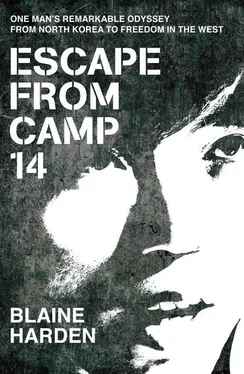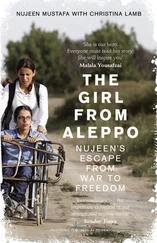Most North Koreans are sent to the camps without any judicial process, and many die there without learning the charges against them. They are taken from their homes, usually at night, by the Bowibu, the National Security Agency. Guilt by association is legal in North Korea. A wrongdoer is often imprisoned with his parents and children. Kim Il Sung laid down the law in 1972: ‘[E]nemies of class, whoever they are, their seed must be eliminated through three generations.’
My first encounter with Shin was at lunch in the winter of 2008. We met in a Korean restaurant in downtown Seoul. Talkative and hungry, he wolfed down several helpings of rice and beef. As he ate, he told my translator and me what it was like to watch as his mother was hanged. He blamed her for his torture in the camp, and he went out of his way to say that he was still furious with her. He said he had not been a ‘good son’, but would not explain why.
During his years in the camp he said he had never once heard the word ‘love’, certainly not from his mother, a woman he continued to despise, even in death. He had heard about the concept of forgiveness in a South Korean church, but it confused him. To ask for forgiveness in Camp 14, he said, was ‘to beg not to be punished’.
He had written a memoir about the camp, but it had received little attention in South Korea. He was jobless, broke, behind on his rent and uncertain what to do next. The rules of Camp 14 had prevented him, on pain of execution, from having intimate contact with a woman. He now wanted to find a proper girlfriend, but said he didn’t know how to begin looking for one.
After lunch, he took me to the small, sad apartment in Seoul that he could not afford. Although he would not look me in the eye, he showed me his chopped-off finger and his scarred back. He allowed me to take his photograph. Despite all the hardship he had endured he still had a baby face. He was twenty-six years old — three years out of Camp 14.
I was fifty-six years old at that memorable lunch. As a correspondent for the Washington Post in Northeast Asia, I had been searching for more than a year for a story that could explain how North Korea used repression to keep from falling apart.
Political implosion had become my specialty. For the Post and for the New York Times , I spent nearly three decades covering failed states in Africa, the collapse of communism in Eastern Europe, the breakup of Yugoslavia and the slow-motion rot in Burma under the generals. From the outside looking in, North Korea seemed ripe — indeed, overripe — for the kind of collapse I had witnessed elsewhere. In a part of the world where nearly everyone else was getting rich, its people were increasingly isolated, poor and hungry.
Still, the Kim family dynasty kept the lid on. Totalitarian repression preserved their basket-case state.
The problem with showing how they did it was lack of access. Elsewhere in the world, repressive states are not always successful in sealing their borders. I had been able to work openly in Mengistu’s Ethiopia, Mobutu’s Congo and Milosevic’s Serbia, and had slipped in as a tourist to write about Burma.
North Korea was much more careful. Foreign reporters, especially Americans, were rarely allowed inside. I visited North Korea only once, saw what my minders wanted me to see and learned little. If journalists entered illegally, they risked months or years of imprisonment as spies. To win release, they sometimes needed the help of a former American president. [5] American television journalists Laura Ling and Euna Lee spent nearly five months in North Korean prisons after crossing illegally into the country in 2009. They were released after former President Bill Clinton flew to Pyongyang and had his picture taken with Kim Jong Il.
Given these restrictions, most reporting about North Korea was distant and hollow. Written from Seoul or Tokyo or Beijing, stories began with an account of Pyongyang’s latest provocation, such as sinking a ship or shooting a tourist. Then the dreary conventions of journalism kicked in: American and South Korean officials expressed outrage. Chinese officials called for restraint. Think-tank experts opined about what it might mean. I wrote more than my share of these pieces.
Shin, though, shattered these conventions. His life unlocked the door, allowing outsiders to see how the Kim family sustained itself with child slavery and murder. A few days after we met, Shin’s appealing picture and appalling story ran prominently on the front page of the Washington Post .
‘Wow,’ wrote Donald G. Graham, chairman of the Washington Post Company, in a one-word e-mail I received the morning after the story appeared. A German filmmaker, who happened to be visiting Washington’s Holocaust Memorial Museum on the day the story was published, decided to make a documentary about Shin’s life. The Washington Post ran an editorial saying that the brutality Shin endured was horrifying, but just as horrifying was the world’s indifference to the existence of North Korea’s labour camps.
‘High school students in America debate why President Franklin D. Roosevelt didn’t bomb the rail lines to Hitler’s camps,’ the editorial concluded. ‘Their children may ask, a generation from now, why the West stared at far clearer satellite images of Kim Jong Il’s camps, and did nothing.’
Shin’s story seemed to get under the skin of ordinary readers. They wrote letters and sent e-mails, offering money, housing and prayers.
My article had only skimmed the surface of Shin’s life. It struck me that a deeper account would unveil the secret machinery that enforces totalitarian rule in North Korea. It would also show, through the details of Shin’s improbable flight, how some of that oppressive machinery is breaking down, allowing an unworldly young escapee to wander undetected across a police state and into China. Just as importantly, no one who read a book about a boy bred by North Korea to be worked to death could ever ignore the existence of the camps.
I asked Shin if he was interested. It took him nine months to make up his mind. During those months, human rights activists in South Korea, Japan and the United States urged him to cooperate, telling him that a book in English would raise world awareness, increase international pressure on North Korea and perhaps put some much needed money in his pocket. After Shin said yes, he made himself available for seven rounds of interviews, first in Seoul, then in Torrance, California, and finally in Seattle, Washington. Shin and I agreed to a fifty-fifty split of whatever the book might earn. Our agreement, though, gave me control over the contents.
Shin began keeping a diary in early 2006, about a year after his escape from North Korea. In Seoul, after he was hospitalized for depression, he continued writing in it. The diary became the basis for his Korean-language memoir, Escape to the Outside World , which was published in Seoul in 2007 by the Database Center for North Korean Human Rights.
The memoir was a starting point for our interviews. It was also the source for many of the direct quotations that are attributed in this book to Shin, his family, friends and prison keepers during the time he was in North Korea and China. But every thought and action attributed to Shin in these pages is based on multiple interviews with him, during which he expanded upon and, in many crucial instances, corrected his Korean memoir.
Even as he cooperated, Shin seemed to dread talking to me. I often felt like a dentist drilling without anaesthetic. The drilling went on intermittently for more than two years. Some of our sessions were cathartic for him, but many made him depressed.
He struggled to trust me. As he readily admits, he struggles to trust anyone. It is an inescapable part of how he was raised. Guards taught him to sell out his parents and friends, and he assumes everyone he meets will, in turn, sell him out.
Читать дальше












